
Switzerland - Swiss Federal Railways SBB-FFS-CFF electric locomotives and EMUs
For a full scale picture, please click on the picture shown !
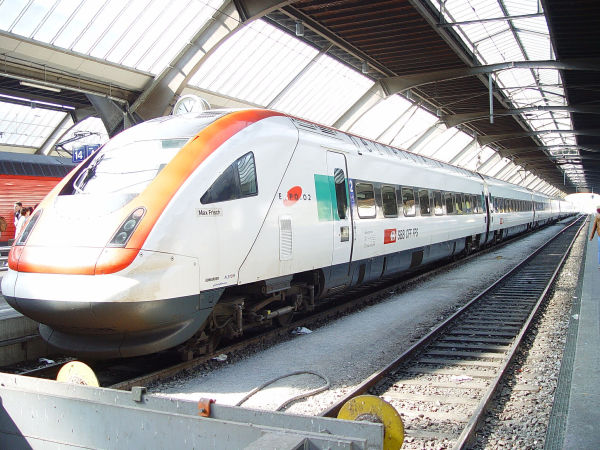
In the mid- and late 1800s Switzerland was already full of different railroads, almost none of which cooperated in any way.
The technical systems as well as ticketing and timetables were a full mess. Industrialisation of the country pressed
on and the need for efficient railroad connections and goods transport became more and more obvious. There was by no means a lack of
railroads: at the end of the 1800s this small country had already 3091 km of normal gauge, 507 km narrow gauge and over 270 km
tram railroad. Finally, in a popular vote - as the Swiss tradition goes - on the 20th February 1898 the Swiss people decided it was
time to socialise the most important railroad companies and "buy them back to the state". The idea of the Swiss state railways
had been born. SBB saw finally daylight as an organisation in 1902 after several complicated political discussions. Important
railroad companies such as the Vereinigten Schweizerbahnen VSB and the Jura-Simplon-Bahn JS were rapidly bought. After extremely difficult
political play also the strategic Gotthard mountain route through the Alps was forcefully taken over from its owners and added to the
SBB network in 1909. SBB got its first at the time modern locomotives in 1907 when the strong and fast A 3/5 steam engines started
pulling first state express trains.
It hasn´t been all smooth sailing and the socialisation was never properly completed, but nevertheless, today´s SBB is clearly one of
Europe´s leading train companies with a large network, modern and impressive trains and surprisingly numerous users - operating on difficult
mountain lines with punctuality taken almost to perfection - something that most other state railroads can only dream about.
The ICN train, also known as RABDe 500 was Switzerland's first actively tilting so called bullet train. It is not prepared for use
outside Switzerland, so its use is strictly limited to Intercity and Interregio trains inside the country. It is especially used on the
Schaffhausen-Zürich-Geneve axis as well as the Zürich-Gotthard basis tunnel-Lugano-Chiasso axis.
Picture of an ICN from Zürich main station 28.9.2002 by Ilkka Siissalo.
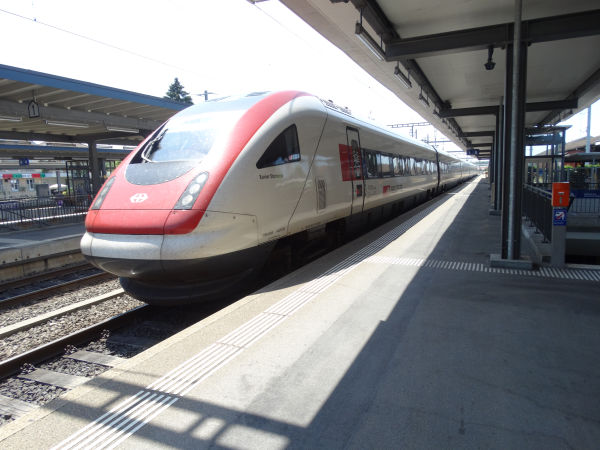
SBB's ICN train named "Xavier Stockmar" stopping at the station of Wil.
Picture by Ilkka Siissalo 4.7.2019.
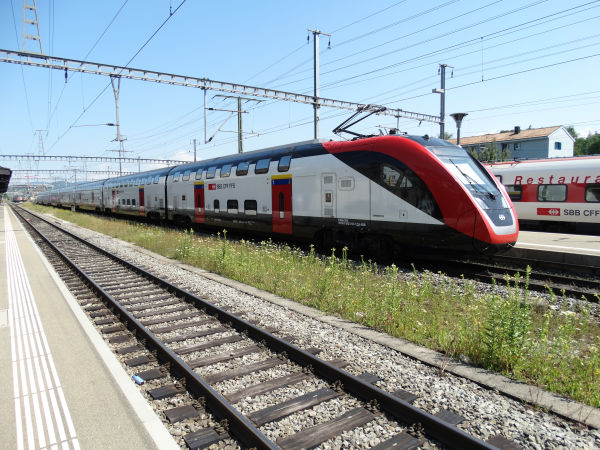
These new RABe 502 doubledecker InterCity trains built by Bombardier entered service at SBB gradually during 2019. In the beginning there were really a lot of
technical troubles, which spoiled the reputation of the trains badly. But in the beginning of 2020 it looks like the situation has gradually stablilised. The
RABe 502 is a remarkably long train and being a doubledecker, its passenger capacity is incredibly large.
Picture from Gossay station 4.7.2019 by Ilkka Siissalo.
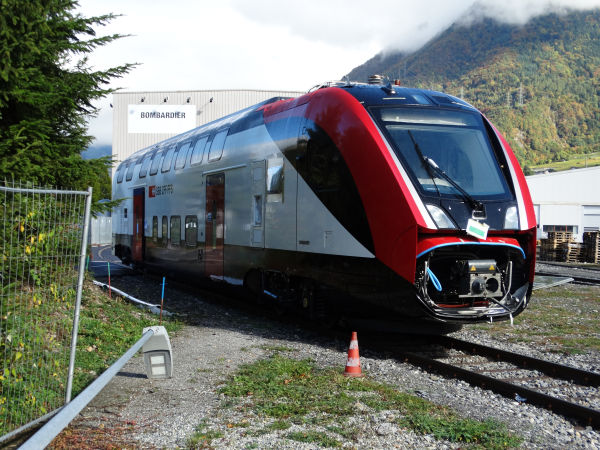
First coach of one of the new RABe 502 trains during early production phase of the new trains. The picture is from the courtyard of Bombardier's factories
in Villeneuve.
Picture from Bombardier Villeneuve 1.10.2017 by Ilkka Siissalo.
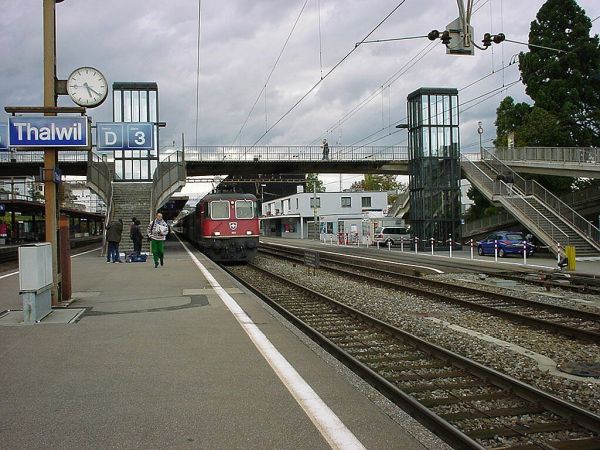
Re 4/4 and Re 460 are probably the two most famous SBB locomotives of all times.
Picture of an Re 4/4 stopping at the station of Thalwil 21.10.2001 by Ilkka Siissalo.
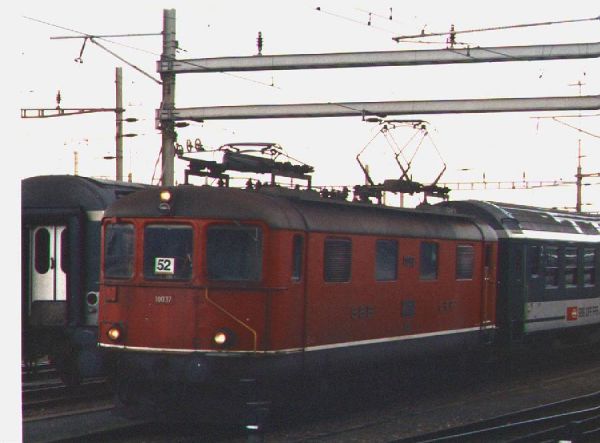
The first generation Re 4/4 locomotives of Switzerland have disapperared except for some museum specimens. A couple
of them are still used by the private BLS Lötschbergbahn to drag heavy cargo trains. But the BLS
Re 4/4 I is not the same as the SBB Re 4/4 I - in fact the BLS construction is from the mid-sixties and
based on modern thyristor technology, whereas the SBB Re 4/4 I series is from the mid-fourties. SBB had
three or four of them still in the late 1990s at the Basel station to perform switcher
locomotive tasks, mainly to move passenger coaches through their wagon washing line, but also they are now long gone. This SBB Re 4/4
1. series no. 10037 seen here at the Basel SBB station was built in 1950. Here it was still in switching work in Basel. It weighs 57 tons and has a maximum
speed of 125 km/h. Its original number in the 1950s was no. 437.
A scanned old paper photo taken in May 1999 by Ilkka Siissalo.
Uploaded Jun 5, 1999

Two first series Re 4/4 locomotives of 1950 still in switcher work at the Basel SBB station.
Photo from May 1999 by Ilkka Siissalo.
Uploaded Jun 5, 1999
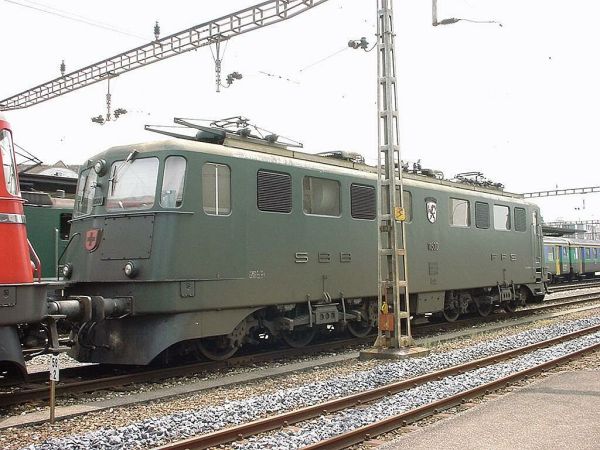
After the second world war traffic on the mountainous Gotthard and Simplon pass railways increased quickly and bigger and
stronger locomotives than the pre-war 1. series Re 4/4´s were quickly needed. This led to the development of a six axle
Co´Co´type locomotive, designed as a universal loco for both fast passenger trains and heavy cargo trains. The type
Ae 6/6 - Swiss pride of the fifties - is powerful, 4300 kW. Prototypes were built in 1952-53 and the type became so popular
that all together 120 units were built between 1952-66. Numbers 11401-11425 look different from the others, with a broad
chromed stripe on the sides (see the red front of a second Ae 6/6 on the left of the picture showing the chrome band).
Number 11500 shown on this picture was built in 1955 by the SLM-BBC-MFO group. It is 18,4 m long, weighs 120 tons and is
designed for speeds up to 125 km/h. The Ae 6/6 was for tens of years the most popular engine in front of fast passenger trains.
However, the stiff 6 axle Co´Co´design of the heavy Ae 6/6 causes by far more stress and damage to railroad tracks than more
modern locomotives, and since the mid-seventies the type was quickly replaced in passenger train use by smaller and more versatile
Re 4/4 3. and 4. series locomotives. Today the old Ae 6/6 is no more in regular use.
Picture from July 1999 at Delemont station by Ilkka Siissalo.
Uploaded 24 June, 2002.
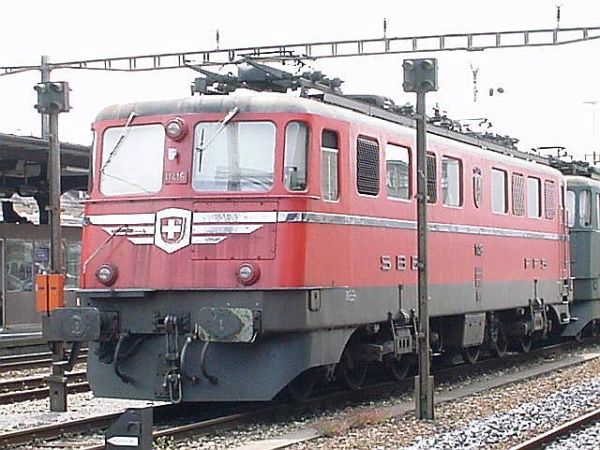
Second view of an Ae 6/6 six axle allround locomotive from the fifties. This number 11416 is from the long series built in 1955.
Every Ae 6/6 got its own name. The first ones were named after the Swiss Kantons, but as these soon ended, the next ones were
named after Kanton capital towns and cities. This one also shows the characteristic broad chrome stripes around the whole
locomotive, which were very typical of the Ae 6/6. Still as late as end of the sixties this type - then painted dark green -
was the most often seen locomotive in front of fast passenger trains and it took care of almost all traffic on the Gotthard
and Simplon mountain routes until finally replaced by the Re 6/6 in late 70s and beginning of the 80s. The original Ae 6/6 shown
here is 18,4 metres long,
weighs 120 tons but has only 4300 kW of pulling power - less than the much smaller Re 4/4, yet it stressed and broke railroad
tracks much more than the smaller Re, especially in curvaceous mountain lines. Maximum speed of the Ae 6/6 is 125 km/h.
Picture in July 1999 by Ilkka Siissalo.
Uploaded 24 June, 2002
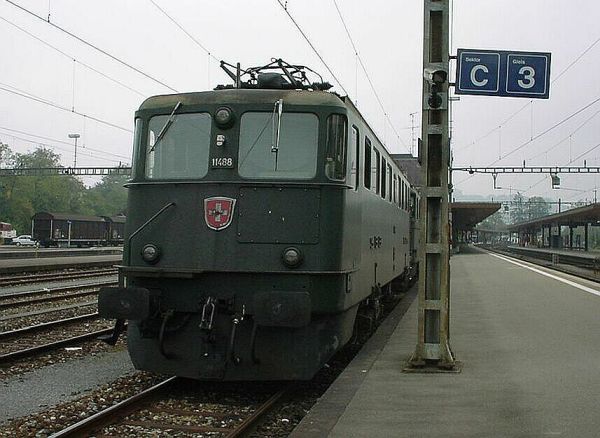
These Ae 6/6 locomotives had been sidetracked as a reserve.
These were the no. 11488 which carries the name "Mendrisio" and no. 11409 "Baselland", sitting idly on a side
track at Bülach station in September 2001. "Baselland" in the back still had the characteristic chrome stripes of the "Kantonsloks", those machines
which were named after the Swiss Kantons, "Mendrisio",
whose front shows properly on the picture, was a so called "Städtelok" or one that was named after the Kanton capital towns.
It has never had them. Both were in the original green colours of the fifties - and as
far as the rust can tell - had not received much attention since they were built in 1955.
The problem of the Ae 6/6 was the
extreme length of the stiff Co´Co´ type bogies which are 4,30 metres long. This means that in steep curves the first and the
last wheels of the bogies cause extreme stresses to the railroad tracks and grind and break them - and Switzerland has more
curves than any other railroad country: 15% of the whole SBB network is curve.
Picture from September 2001 by Ilkka Siissalo.
Uploaded 24 June, 2002
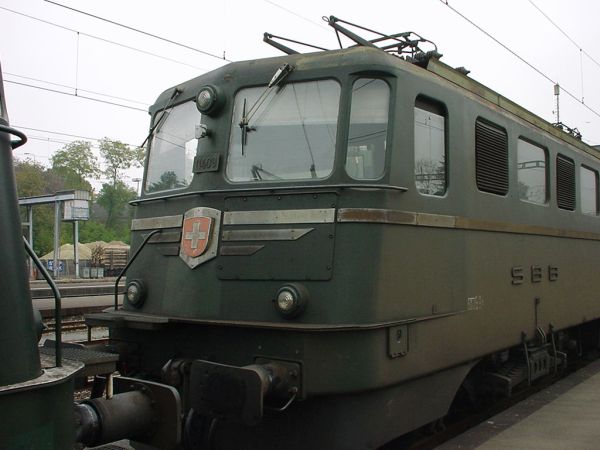
Closeup of the front of Ae 6/6 no 11409 "Baselland". If it were not so dirty and rusty it would still have been a good and fairly modern
looking locomotive. The designers of SLM and BBC did a good job in mid-fifties.
Picture in September 2001 at Bülach station by Ilkka Siissalo.
Uploaded 24 June, 2002
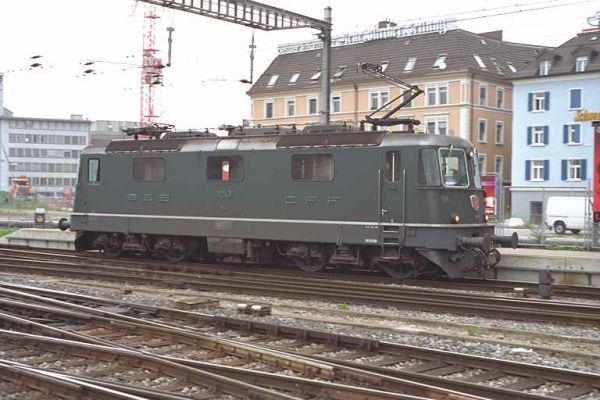
SBB Re 4/4 II series no. 11243 at Zürich Hbf. 19 September 1995. This one is from the long series built in 1969 and it is here
still in its original dark green livery.
Photo by Erik Hjelme.
Uploaded Nov 23, 1995

An unidentified SBB Re 4/4 III series locomotive at Zürich Hbf. 19th September 1995.
Photo by Erik Hjelme.
Uploaded Nov 23, 1995
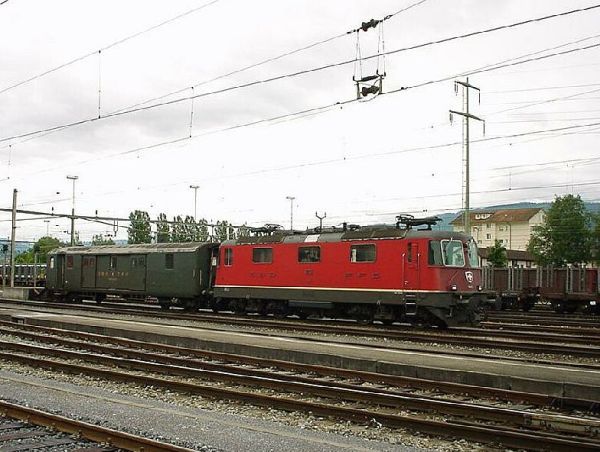
SBB Re 4/4 III no. 11352 of the 3. generation from the last series of 1971 - a little bit longer than Re 4/4 II, with rectangular
lights. At that time, although a more modern construction (the Re 4/4 IV or what is today Re 446 at the Südostbahn) existed
already, the SBB needed more allround locomotives and did not want to mess with the "children´s sicknesses" of the 4. generation
and wanted instead more of the old, but well known and well liked stuff. This variant was a little longer and a little more
powerful; it was designed specifically with the Gotthard mountain line in mind. The locomotive is 15,41 metres long (Re 4/4 II
is 14,8 or 14,9 m), weighs 80 tonnes, has a maximum speed of 125 km/h (as opposed to 140 of the earlier ones) and generates
4700 kW of power (like the old one), but can have a pulling force of 280 kN (as opposed to 167). Partly later replaced by the
much bigger and more powerful Re 6/6, these allrounders can still be seen all over Switzerland - like here on the Juraline in Delemont
in the north - but are still most often used on the Gotthard line bundled together with an Re 6/6 to create what is called
Re 10/10 "virtual locomotive": a commonly seen pair.
Photo from Delemont with a 1970´s aluminium mail coach in 1999 by Ilkka Siissalo
Uploaded 20 June, 2002

The Re 6/6 with its power of 7900 kW was for a long time the strongest locomotive in the world (and Switzerland). It has
6 axels in the somewhat rare Bo´Bo´Bo´ order. The first 4 prototypes built
in 1972 had an articulated joint for improved bending in tight curves, but
this was omitted as unnecessary in the series of 1975 (shown).
Photo of an unidentified Re 6/6 at Basel SBB station in May 1999 by Ilkka Siissalo.
Uploaded May 24, 1999

This somewhat dark (sorry for that!) picture of an unidentified Re 6/6 and 2.series Re 4/4
shows the similarity and difference in size of these two famous locomotives. The Re 4/4
2.series has 4 axles, was built 1969-83 in almost 200 copies and was in the 1990s the most often seen
locomotive in front of passenger trains. The 6 axle "big brother" Re 6/6 is used mainly on
the Gotthard railroad and in front of extremely heavy cargo trains. The usual "Gotthard combination"
is one of both, forming a 10 axle really powerful combination.
Photo near Basel SBB station in May 1999 by Ilkka Siissalo.
Uploaded May 24, 1999
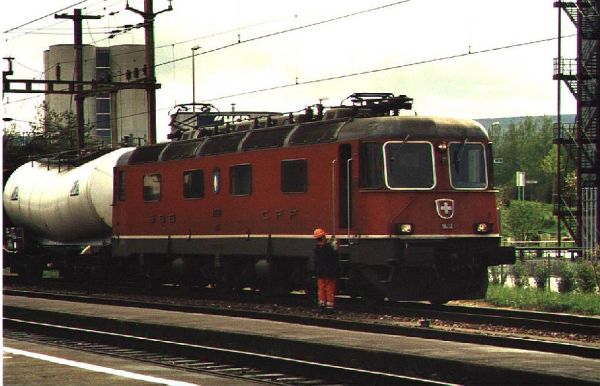
SBB Re 6/6 no 11632 in front of a particularly heavy cargo train, stopping at the
Münchenstein station to pick up a new driver. This locomotive, built in 1975 is
one of a very successful series of 85 engines - still the most powerful locomotive
of Switzerland. On this Juraline and also on the Gotthard line, when the power of an Re6/6
is not enough, these engines are often combined together with the similar but smaller Re4/4.
Photo May 1999 by Ilkka Siissalo.
Uploaded Jun 5, 1999
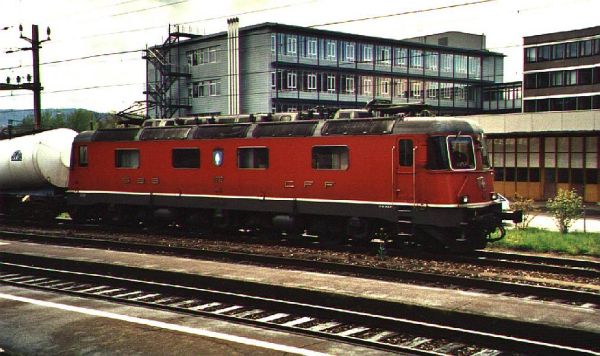
SBB Re 6/6 no 11632 shown sideways so that its remarkable length and six Bo´Bo´Bo´ evenly
dispersed axles are shown. To be able to slightly bend in curves at high speed, specially
designed bearings are used; the middle axles can move sideways. Photo from Münchenstein, May 1999
by Ilkka Siissalo.
Uploaded Jun 5, 1999
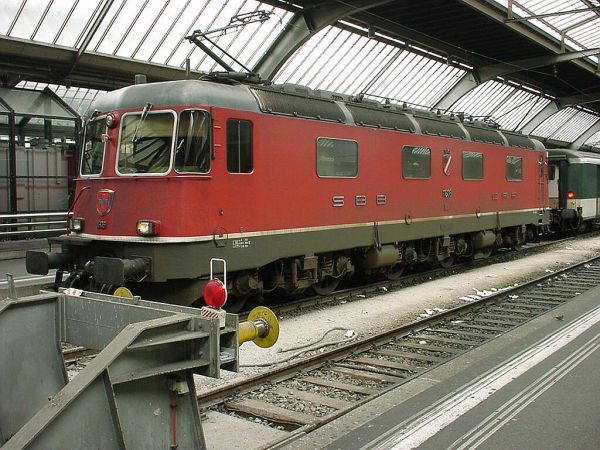
A closeup view of the Re 6/6 no. 11606 from the second series, built in 1975. It is still by today´s standards a
remarkably good looking engine, although the basic design is already from the 1960s.
Photo at Zürich Hauptbahnhof 9.6.2002 by Ilkka Siissalo.
Uploaded June 20th, 2002.
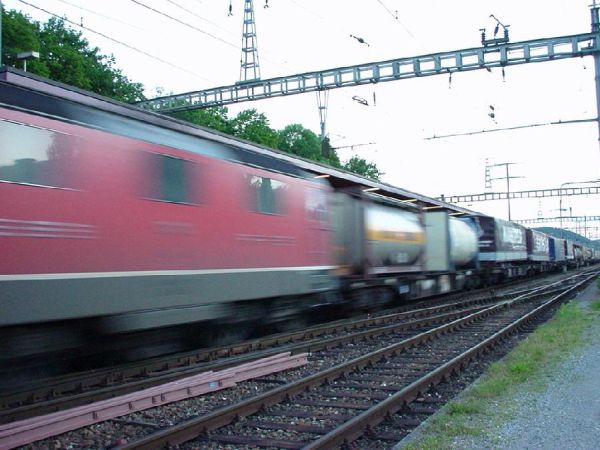
The shutter speed of a Sony digital camera is not nearly fast enough to stop the movement of a
heavy cargo train rushing full speed southwards, probably towards the Gotthard line. Headed
by one Re 6/6 and one Re 4/4 which both have a maximum allowed operating speed of 140 km/h
the train encompasses more than 30 heavy cargo wagons.
Photo 4th of June 1999 in Rheinfelden by Ilkka Siissalo.
Uploaded Jun 5, 1999.
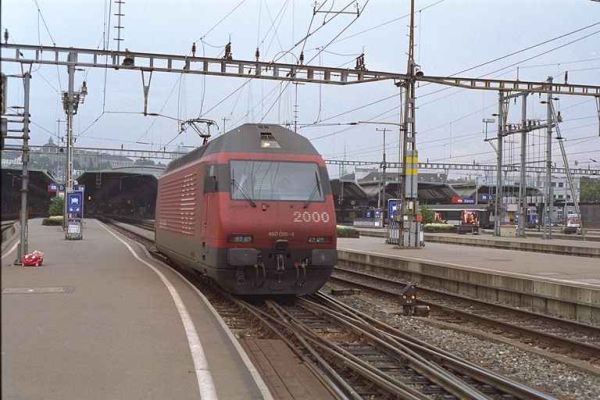
SBB Re 460 'Lok 2000' (VI generation of Re 4/4) no. 28 at Zürich Hbf, 19th September 1995.
Photo by Erik Hjelme.
Uploaded Nov 23, 1995.
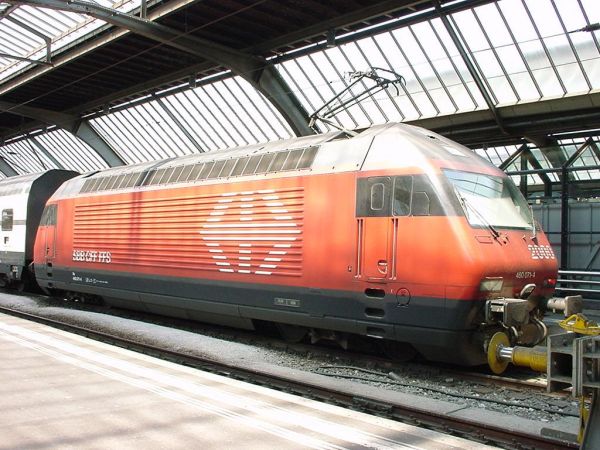
Another view of the "Lok 2000" or Re 460. Nowadays many of the Re 460s have lost their
original red painting in favor of sometimes very ugly commercial liveries acting as moving ads for this or that product.
Here is still the mighty locomotive as it is. Its maximum speed is a thrilling 230 km/h. In practise speeds of up to
200 km/h are actually used on the main lines. Photo from Zürich Hauptbahnhof (main station) in 1999 by Ilkka Siissalo.
Uploaded 24 June, 2002
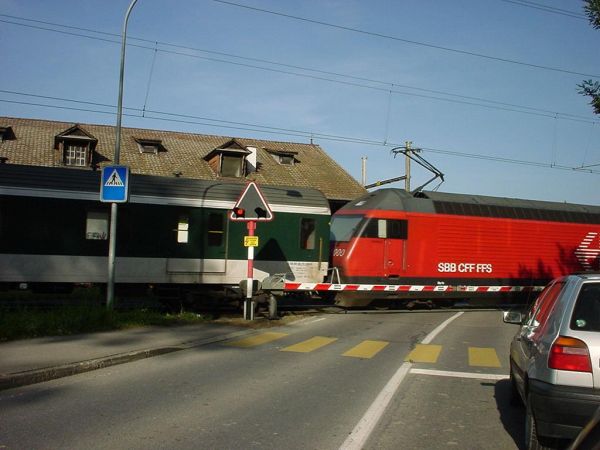
A quick shot from a car window: an express train on the way from Bern towards Thun and Interlaken in full speed, probably well
over 120 km/h, by the Worb SBB station. The locomotive Re 460 or "Lok 2000" with its stylish Pininfarina design is
the pride of the Swiss. These locomotives have also been sold to e.g. Norway and Finland. Germany was highly interested in
buying them as well, but could not afford the "astronomical" (as they put it) price. They developed instead their present-day Baureihe 101 and
145 locomotives based on the so called "EuroSprinter" concept. In Finland the admittedly beautiful and powerful "Lok 2000" was
not such an immediate success, as the state VR complained about overheating wheel bearings - "Something absolutely unacceptable
in this class and this priced locomotives" as they put it. SBB has in Switzerland 119 of these beautiful locomotives and they
form the basis of all high speed traffic nowadays. Photo 14.10.2001 in Worb near Bern by Ilkka Siissalo.
Uploaded June 20th, 2002
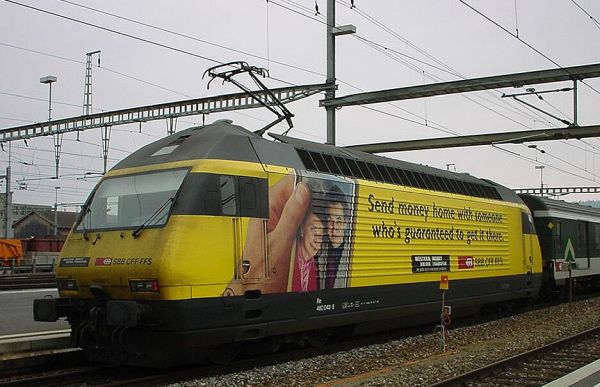
Many of the modern SBB locomotives of the "Lok 2000" are painted or taped in advertisement colours; here an example of no. 42, which on 1st
November 2001 was advertising international money transfers, presumably for the tens of thousands of foreigners who live and work
in Switzerland and send money back home. Some of the advertisements look fairly tasteless; this one is actually not too bad, but
the nice looking locomotive would definitely benefit from a good wash :-) Here the locomotive was pushing an IC train from Zürich
to Geneve airport, and making a halt at Yverdon.
Photo from Yverdon station 1. Nov. 2001 by Ilkka Siissalo.
Uploaded June 20th, 2002.
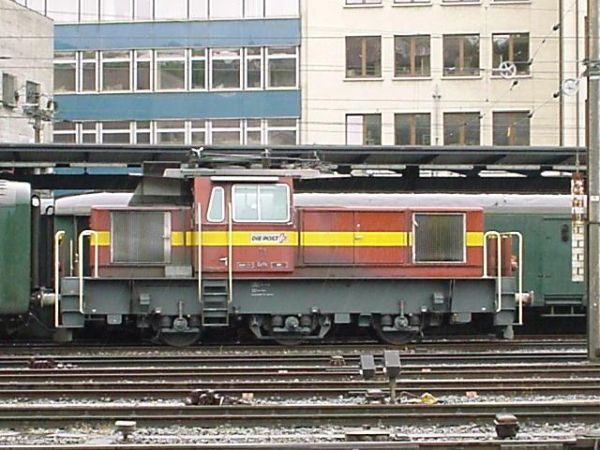
An unidentified Ee 3/3 locomotive of the Swiss Post and Telecom PTT, switching mail wagons
at Bern Hauptbhanhof (main station). These small electric engines were built in 1991. It weighs 48 tonnes,
is only 11,20 m long and has a maximum speed of 75 km/h. Builder is the SLM/ABB group which later became
part of Adtranz and finally Bombardier group.
Photo from Bern station in June 1999 by Ilkka Siissalo.
Uploaded Jun 6, 2002.

A small electric SBB locomotive of the Te 2. series of 1967, no. 79, night time at
Liestal station, Baselland. Te´s were built by SLM, Tuchschmid AG and Maschinenfabrik
Oerlikon. The locomotive weighs 22 tons and has a maximum speed of 60 km/h.
Photo in November 1998 by Ilkka Siissalo.
Uploaded May 24, 1999.

The Tem 3.series locomotive no. 328 is actually not classified by SBB as a
locomotive but a "rail tractor" with both a diesel and an electric engine.
It is used in light switching work and in rail construction work as a
helper. Built by SLM, Secheron and Brown Boveri, it weights 32 tons and
has a maximum speed of 60 km/h.
Photo from Münchenstein, May 1999 by Ilkka
Siissalo.
Uploaded Jun 5, 1999.
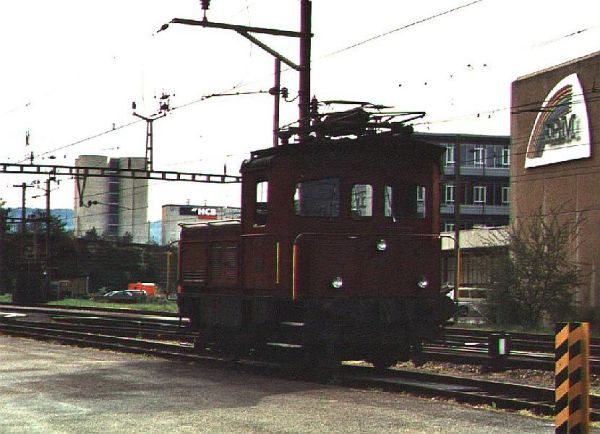
The Tem 3.series no. 328 seen from the other side. It doesn´t look like a tractor to me !
Photo from Münchenstein, May 1999 by Ilkka Siissalo.
Uploaded Jun 5, 1999.
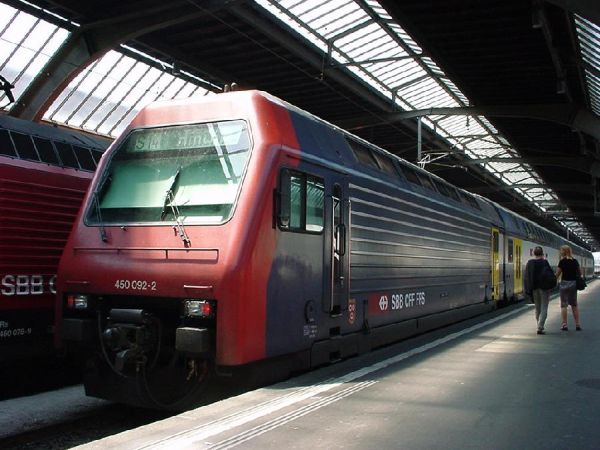
A typical Zürich S-Bahn, here still unmodernised, an Re 450 (or 5. generation Re 4/4) with always 3 double decker coaches,
the last one of which has a cockpit very similar to the one at the locomotive end. The Re 450 is a modification
actually of the Re 460 "Lok 2000", the pride of Switzerland, but intended only for the use of pulling or pushing double
decker coaches at the Zürcher S-Bahn. For this purpose it does not have to be as fast or as powerful as the
original Lok 2000, but it still retains some of the design features. SBB has 115 of these locomotives (and 3
coach units attached to them), built 1989-97. The locomotive itself is 18,4 metres long, weighs 74 tonnes and
has a maximum speed of 130 km/h.
Photo from Zürich Hauptbahnhof (main station) in 1999 by Ilkka Siissalo.
Uploaded 24 June, 2002.
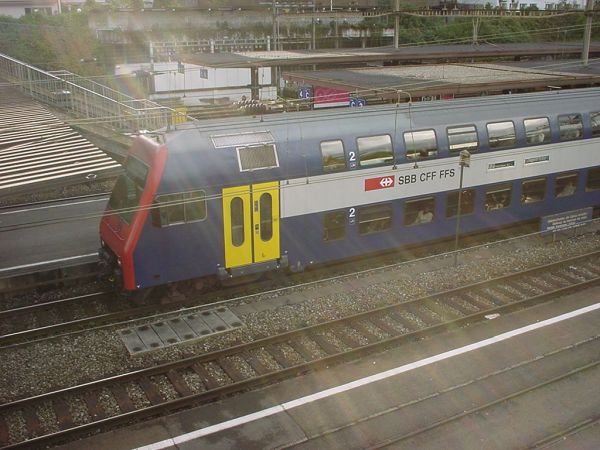
A steering cab coach of a typical Zürich S-Bahn train Re 450.
Photo from Thalwil station 21.10.2001 by Ilkka Siissalo.
Uploaded 24 June, 2002.
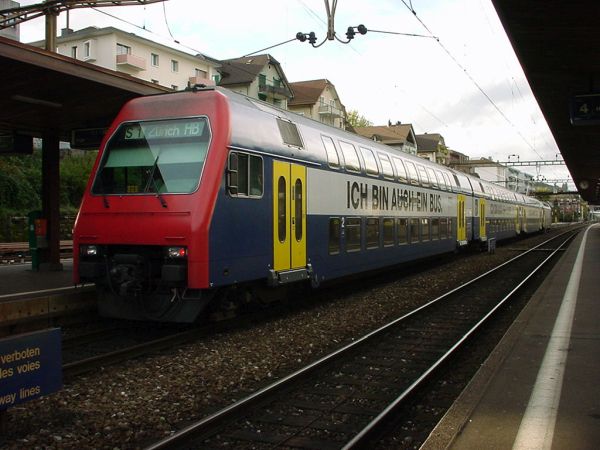
The Re 450 with its train is always a fixed 3 coach plus locomotive unit. At peak traffic two units may be coupled together.
SBB has 115 of these units, built between 1989 and 1997.
Photo from Thalwil station 21.10.2001 by Ilkka Siissalo.
Uploaded 24 June, 2002.
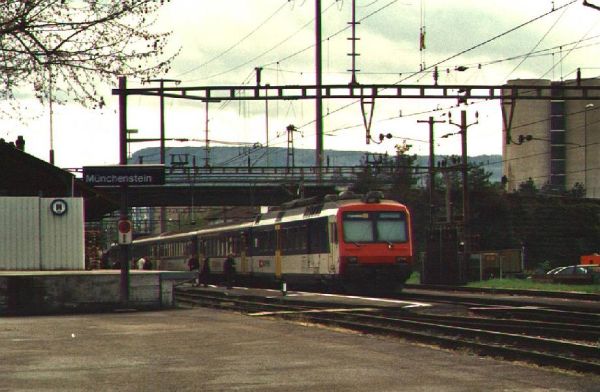
A typical modern Swiss regional train of the 1980´s (so called NPZ concept train),
an unidentified RBDe 560 1. series electric motor unit of the SBB on its way from Basel to Laufen on the
Juraline, stopping here at the Münchenstein station close to Basel. The first
prototypes of these trains were ordered by SBB in 1984 based on the good
experiences of similar trains of private companies such as the BLS.
Basically the same train, with some modifications, is in use within several
private Swiss railroads and also in Germany in the Bodensee area. Its
maximum speed is 140 km/h (some variants 125 km/h). For the Basel area
traffic SBB had six units designated RBDe 562 for the
Regio-S-Bahn-Basel-Mulhouse service, which had dual electric systems, both for the
German/Swiss 15 kV 16,7 Hz and for the French/Italian/Spanish/Hungarian
etc. 25 kV 50 Hz. These trains used to run on pendel routes via Basel, where the other
end was in Mulhouse (Müllhausen) in French Alsace (Elsass) and the other
end in Switzerland, for example in Laufen, where this train is going to.
Photo May 1999 by Ilkka Siissalo.
Uploaded Jun 5, 1999.
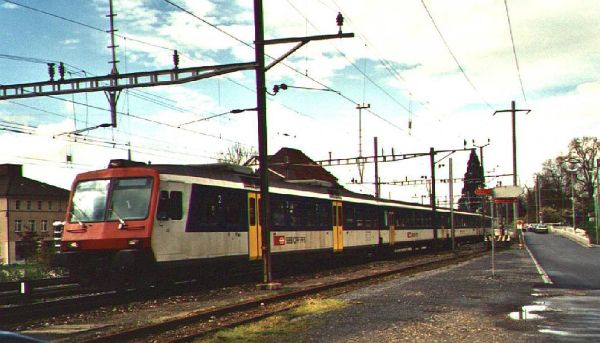
An unidentified SBB RBDe 560 1.series EMU (maybe RBDe 562) leading a long train from Basel to the Münchenstein
station on its way to Laufen on the Juraline.
Photo May 1999 by Ilkka Siissalo.
Uploaded Jun 5, 1999.
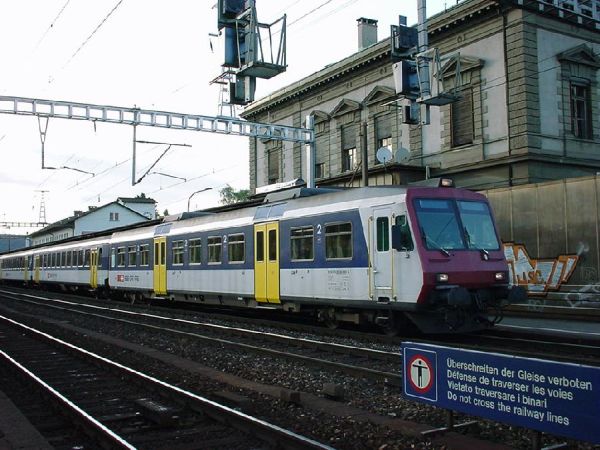
A typical Swiss regional EMU train of the federal SBB, here a fairly long one, with an RBDe
560 series electric motor unit pushing from the back and a matching coach with a steering cab coach
in front. Photo 4th of June 1999 at Liestal station by Ilkka Siissalo.
Uploaded Jun 5, 1999.
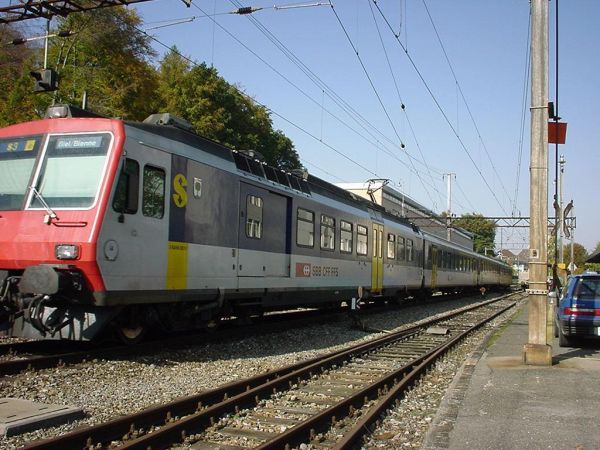
Closup of a suburban SBB commuter train of the type RBDe 560, this time with a yellow S-Bahn-Bern
stripe on its side. Photo of SBB RBDe 560 on S-bahn line S3 on 15.10.2001 at Bern-Weissenbühl station, on its
way from Thun via Bern to Biel by Ilkka Siissalo.
Uploaded June 20, 2002.
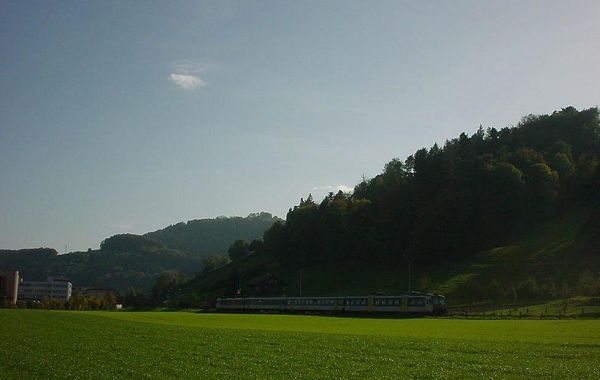
A typical Swiss regional train, powered by an RBDe 560 unit in a nice countryside setting close to Belp, on the
Bern S-Bahn S3 line between Bern and Thun.
Photo 14.10.2001 by Ilkka Siissalo.
Uploaded June 20, 2002.

Wait a minute ! Something is wrong ! :-)
It looks like a very normal suburban commuter train, but it´s not normal at all. These regional trains are
always driven by the RBDe 560 series electric motor units, which look very much the same as the coaches, or, in rare cases,
by older EMUs like the RBDe 540. This train is missing its EMU motor wagon and has received an Re 4/4 universal locomotive
in its place to replace it. State SBB had a shortage of its RBDe 560 EMUs due to repairs and similar
instances and this kind of odd combinations were seen sometimes in short haul S-Bahn traffic in Bern and Basel.
Photo from Wangen, near Bern 14.10.2001 by Ilkka Siissalo.
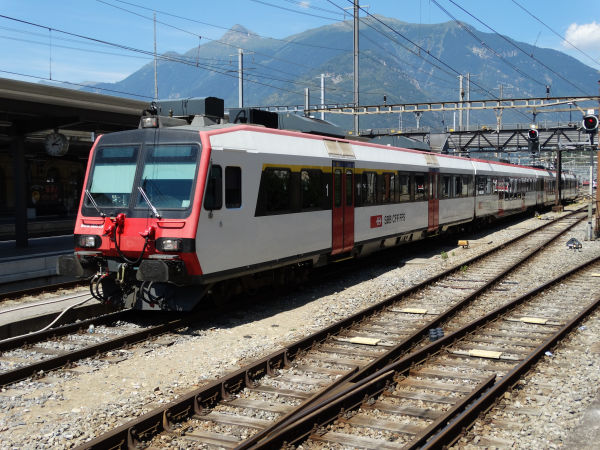
After a thorough modernisation and addition of new low-floor middle coaches, an ols RBDe 560 train looks almost like new. After
modernisation SBB calls these trains now "Domino" trains.
Picture of a four-coach Domino at the station of Bellinzona 5.7.2019 by Ilkka Siissalo.
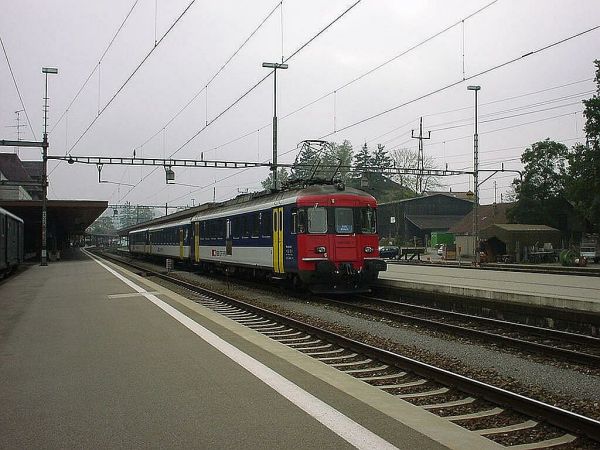
The RBe 540, or originally RBe 4/4 was first built in a 5 train prototype series in 1959 and then in series between 1963 and
1969. Altogether SBB had 76 of these trains. Originally painted dark green, they were used in fast long haul train connections,
as e.g. express trains between major cities, for example between Zürich and Bern and Geneve. They were the new, modern trains which
took care of most of the visitor traffic at the "Landesausstellung 1964", the major national exhibition of the sixties. Later
when traffic increased, these motor wagons were pushed to do S-Bahn service, mainly as the workhorses in front of heavy and
long short haul commuter S-trains. In 1991 the trains were thoroughly refurbished, repainted and got their new numbering RBe
540. Today they are used only rarely and in less important S-Bahn services, like here between Bülach and Schaffhausen.
Picture in September 2001 from Bülach station by Ilkka Siissalo.
Uploaded 24 June, 2002.

Closeup of the front of the RBe 540 no.38. This electric motor unit was built in 1963, it weighs 68 tonnes, has a maximum speed
of 125 km/h and is 23,7 metres long.
Picture in September 2001 from Bülach station by Ilkka Siissalo.
Uploaded 24 June, 2002.

As many other national railways, now also the Swiss federal SBB has ordered modern electric motor units, so called "bullet trains".
These trains, called ICN (InterCity Neigezug) or "Weisse Pfeil" (white arrow), were first delivered by ADtranz in 2000 and
are now most often seen on the line
between Zürich and Geneve airport, but also between Zürich and Winterthur or Schaffhausen or St. Gallen and Lausanne. In contrast
to the similar trains in other countries - like the ICE in Germany or TGV in France - the ICNs are not particularly fast.
They could be, but the timetables are organised in such a way that the trains keep frequently stopping even at small and
unimportant stations like here in Oensingen. In fact they are even used in InterRegio services. Anyway, the trains are modern and
comfortable. In November 2000 SBB had 13 units of the ICNs. They are always used as two unit combinations, giving a train 14
coaches long, with 940 sitting places. The ICN is based on the Italian Pendolino by Fiat, but built completely at ADtranz in
Pratteln, close to Basel. One unit is 188,8 metres long, has 113 1. class, 12 business class and 326 2. class seats plus a
restaurant with 23 seats. Each unit has 8 motors and 28 axles in 7 coaches. Maximum speed is a modest - for a modern "bullet
train" - 200 km/h.
Photo from Önsingen station 14.10.2001 by Ilkka Siissalo.
Uploaded 24 June, 2002.
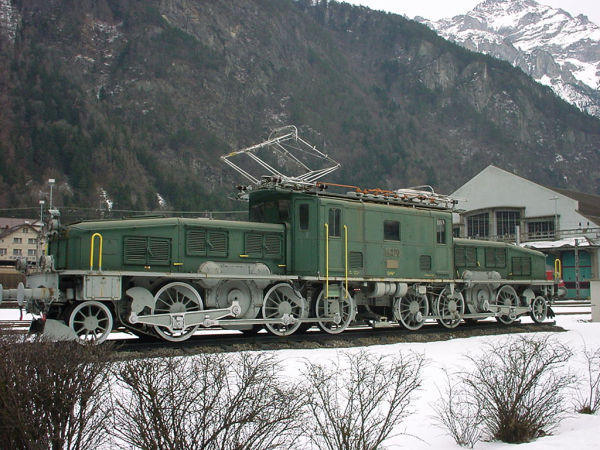
This is one of the famous "Swiss crocodile" locomotives of the class Ce 6/8 II, the no.14270. SBB had altogether 51 of these locomotives which
had articulated bending joints. They were built 1919 to 1921. weighed 128 tons and had a maximum speed of 70 km/h. It could produce
2721 kW of power at 45 km/h. This one was for many years on display as a monument at the SBB depot in Erstfeld, but now it has been
renovated and put again in working order.
Picture from Erstfeld 19.1.2002 by Ilkka Siissalo.
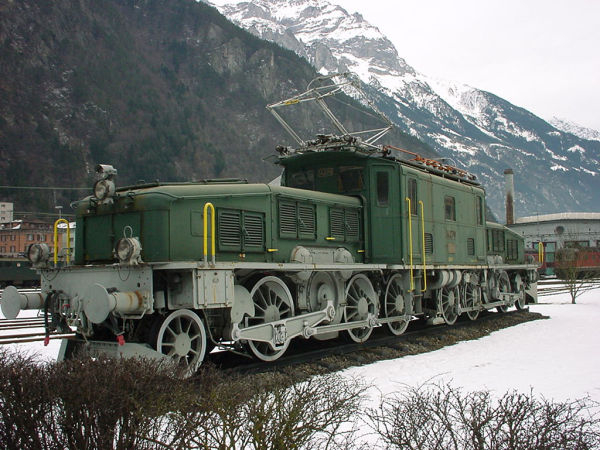
The same Crocodile Ce 6/8 II no. 14270 seen from its front.
Picture from Erstfeld 19.1.2002 by Ilkka Siissalo.
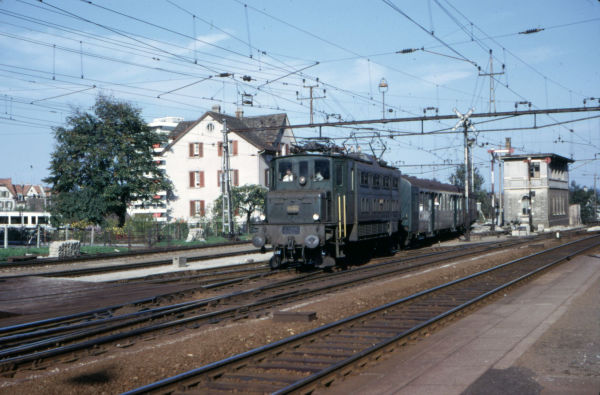
SBB's class Ae 3/6 electric locomotive with a rake of light metal middle door coaches is approaching the station of Zürich-Oerlikon to then
continue towards Zürich Hbf. Picture taken with a dia slide film camera by Aarne Siissalo, father of the present chief editor of this service.
At the time when this photo was taken, the present day chief editor was six years old and stood eagerly by as daddy took the picture. This one
is the Ae 3/6 no.10604. These locomotives of the class Ae 3/6 I were built 1920 to 1929 and there were 114 of them, numbered 10601–10714. They
were scrapped between 1974–1994. It was a 92 to 96 tons weighing machine with a Buchli traction system with a power rating of 1600 kW and a top
speed of from 90 to 110 km/h. This one was one from the very first series, bult by BBC. They were intended mainly for flatland traffic especially
close to the major cities - like here.
Picture is from Zürich-Oerlikon station, taken some time during the summer of 1967.
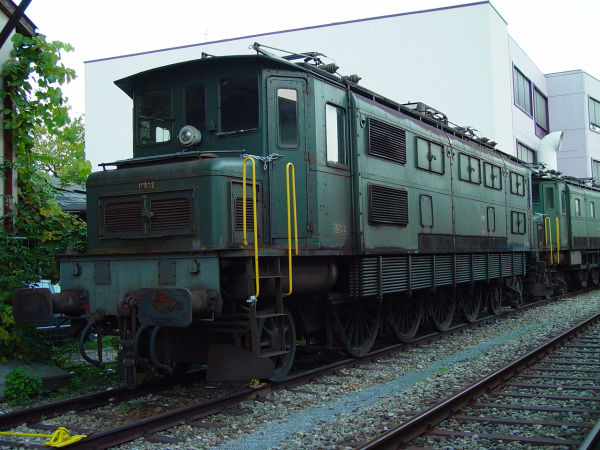
SBB's class Ae 4/7 was the one axle longer, much heavier and stronger variant of the Ae 3/6 shown above. The last Ae 4/7 locomotives were taken out
of regular use in 1995-96 but they were kept in running order for many more years as some kind of a strategic reserve. Two of these Ae 4/7 locomotives
which were stored as a reserve were for several years kept in Dreispitz in Basel. This is one of them. In the 1920s this was a remarkably strong and
fast locomotive with a top speed of 100 km/h.
Picture from Basel Dreispitz 9.10.2002 by Ilkka Siissalo.
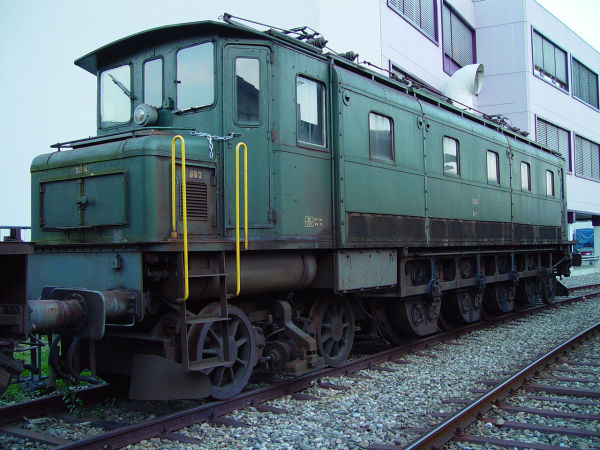
The other one of the two Ae 4/7 locomotives which for many years were stored at Dreispitz in Basel. They happened to be parked one the other way round
with the other, so comparing these two pictures one can get a good idea how they looked like. Due to their Buchli mechanism of power transmission the
different sides of the locomotives were highly asymmetrical.
Picture from Basel Dreispitz 9.10.2002 by Ilkka Siissalo.

